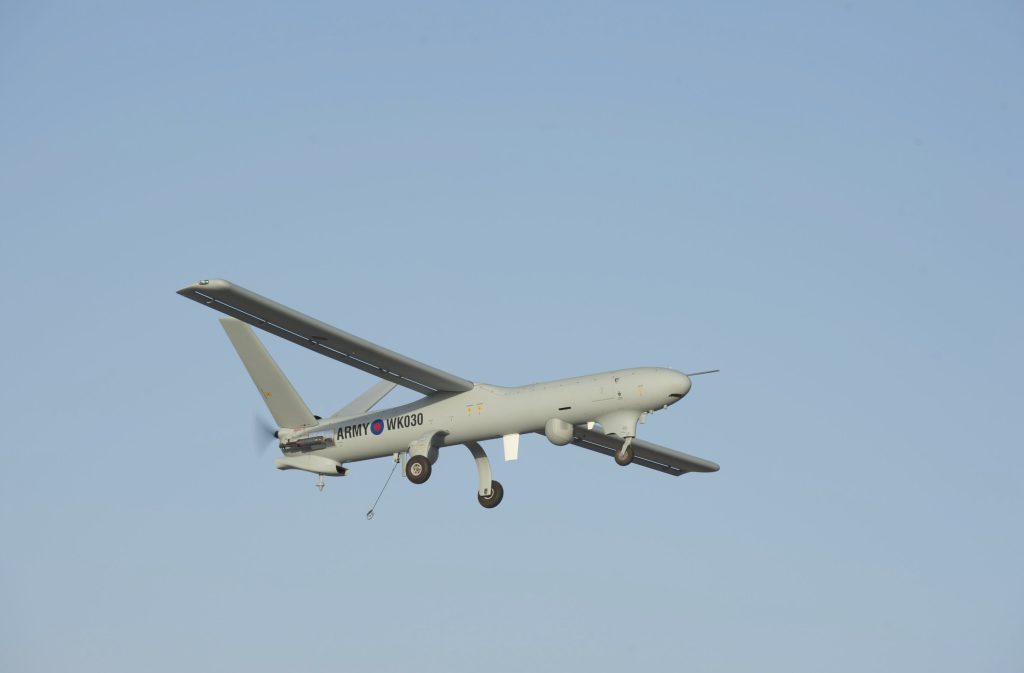UK launches Project Corvus; its Watchkeeper replacement
The UK has announced Project Corvus in a market engagement notice as it seeks to replace its struggling fleet of Watchkeeper unmanned aerial vehicles (UAVs). The notice was released on the 15th April and states that the UK is seeking engagement from industry partners to shape the acquisition strategy. The initial deadline for input is the 30th April.
Project Corvus is aiming to meet the UK’s Land Tactical Deep Find, 24hr persistent surveillance requirement. It will be operated by the Royal Artillery’s 47th Regiment, and the stretch goal is to have a “Minimum Deployable Capability” within 2025, the announcement states.
The procurement is described as a CAT B project, with the initial procurement estimated to have a value between £130 million and £156 million (approximately €151.19/$173.81 million to €181.43/$208.57 million) excluding VAT.
The project is looking for “two task lines” each capable of operating for 24 hours. This may mean two orbits of UAVs, which typically means six UAVs allowing for one to fly, one to be made ready to fly, and another to be ready to fly. This helps a force maintain persistence surveillance over an area.
The stated key user requirements are as follows:
- Conduct land ISTAR across the “corps and divisional deep battlespace.” The concept of deep is often debated within the British Army, some think of it as anything beyond line of sight, while others tend to assume an effects-based definition. I.e., command and control nodes, ammunition depots, and so on. However, in this case, it is safe to assume that it will be required to patrol up to 150 km in range to find targets for the UK’s Deep Recce-Strike Brigade Combat Team.
- Conduct persistent, and wide area ISTAR by accurately Detecting, Recognising, Identifying, tracking, and designating land and maritime targets in real-time using payloads in cooperation.
- Securely communicate with other users and disseminate ISTAR information and platform data at a low-latency, integrating with existing processing and exploitation systems. This may include software platforms designed to fuse multiple sensor inputs into a single operational picture.
- It is also expected to operate robustly in contested airspace and GPS-denied environments. This aspect is a little challenging. The GPS-denied element is addressable, solutions like FlareBright’s Tactera could provide a reasonable solution to the navigation problem. But contested airspace is much more difficult; the Houthis, with a limited air defence capability, routinely claim to shoot down US MQ-9s, which operate at higher altitudes than the Corvus is likely to. So, the ability to operate in contested airspace either implies a platform cheap enough to be expendable, or somehow resistant to kinetic interceptions.
- Several of the key user requirements indicate that the platform should be deployable quickly and not require any expansion of 47 Regiment’s existing workforce.
- It is required to be technologically agile, and support spiral upgrades and developments indicating some element of software defined capability.
- Finally, it is required to meet the UK’s Land Industrial Strategy Objectives Framework, which typically requires the equipment manufacturer to produce a certain percentage of the product in the UK.
The end of Watchkeeper

This image shows a Watchkeeper UAV in Afghanistan in 2014 shortly after the MoD had declared it to be fully operational in the country. A full release to service would take another five years. Credit: Crown copyright/UK MoD
Watchkeeper is based on the Hermes 450 UAV from Elbit and manufactured through a joint venture with Thales and Elbit. It is an infamous and troubled programme in the UK that was initiated in 2000 with a contract awarded to Thales and Elbit in 2004. The British MoD eventually revealed in 2007 that 54 Watchkeepers would be delivered under a contract valued at £800 million (approximately €1184 million/$1632 million at the time). This included the UAVs as well as changes to British airfields and bases to house the systems. However, the Watchkeeper did not receive its full release to service until 2019 after a long and troubled development and deployment process. By 2022, eight Watchkeepers had been lost through crashes and training incidents, and in 2023 it was revealed the programme had cost £1.35 billion (approximately: ). By 2024, just 11 Watchkeepers were operational and the decision was taken to retire the fleet in a bid to plug spending gaps within the British MoD.
Calibre comment
Project Corvus is likely to attract a lot of initial market interest. The manufacturer landscape for this type of capability has changed significantly since the Watchkeeper procurement was initiated, which may mean that the British MoD is faced with a plethora of options beyond the traditional primes that it is used to dealing with. This could be an opportunity for the UK to procure a capability that is very beneficial to the Army and meaningfully contributes to tripling lethality as it is currently planning. However, it also opens up further risk in that there may be attractive but unproven technologies alongside more standard and familiar systems presented.
Either way, this is a critical procurement for the British Army, which struggles to fully resource its aerial ISTAR needs as currently stands, and will be reliant upon its artillery to degrade an opponent sufficiently to improve survivability of its armoured forces.
If you would like to learn more about autonomy and the systems that are shaping defence, consider signing up for the Calibre Defence newsletter via the Calibre homepage. The newsletter is released on a monthly basis and dives into a single topic each time. The April issue will focus on Russia’s Lancet family of loitering munitions, and May will discuss the trade-offs between cheap mass, and smaller numbers of boutique capabilities.
By Sam Cranny-Evans, published on 22nd April, 2025.

Sign Up for Updates!
Get insider news, tips, and updates. No spam, just the good stuff!






